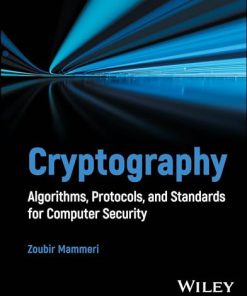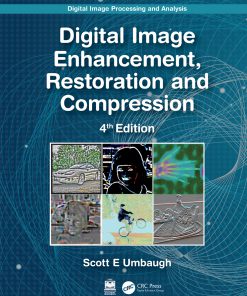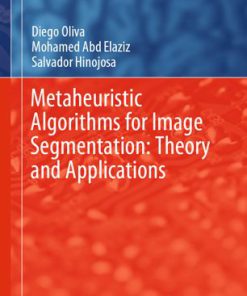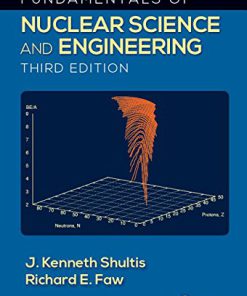Image and Video Compression for Multimedia Engineering Fundamentals Algorithms and Standards 3rd Edition by Yun Qing Shi, Huifang Sun ISBN 1351578642 9781351578646
$50.00 Original price was: $50.00.$25.00Current price is: $25.00.
Image and Video Compression for Multimedia Engineering Fundamentals, Algorithms, and Standards 3rd Edition by Yun Qing Shi, Huifang – Ebook PDF Instant Download/Delivery: 1351578642, 9781351578646
Full download Image and Video Compression for Multimedia Engineering Fundamentals, Algorithms, and Standards 3rd Edition after payment
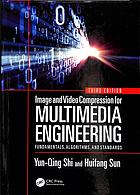
Product details:
ISBN 10: 1351578642
ISBN 13: 9781351578646
Author: Yun Qing Shi, Huifang
The latest edition provides a comprehensive foundation for image and video compression. It covers HEVC/H.265 and future video coding activities, in addition to Internet Video Coding. The book features updated chapters and content, along with several new chapters and sections. It adheres to the current international standards, including the JPEG standard.
Image and Video Compression for Multimedia Engineering Fundamentals, Algorithms, and Standards 3rd Table of contents:
Part I Fundamentals
1. Introduction
1.1 Practical Needs for Image and Video Compression
1.2 Feasibility of Image and Video Compression
1.2.1 Statistical Redundancy
1.2.1.1 Spatial Redundancy
1.2.1.2 Temporal Redundancy
1.2.1.3 Coding Redundancy
1.2.2 Psychovisual Redundancy
1.2.2.1 Luminance Masking
1.2.2.2 Texture Masking
1.2.2.3 Frequency Masking
1.2.2.4 Temporal Masking
1.2.2.5 Color Masking
1.2.2.6 Color Masking and Its Application in Video Compression
1.2.2.7 Summary: Differential Sensitivity
1.3 Visual Quality Measurement
1.3.1 Subjective Quality Measurement
1.3.2 Objective Quality Measurement
1.3.2.1 Signal-to-Noise Ratio
1.3.2.2 An Objective Quality Measure Based on Human Visual Perception
1.4 Information Theory Results
1.4.1 Entropy
1.4.1.1 Information Measure
1.4.1.2 Average Information per Symbol
1.4.2 Shannon’s Noiseless Source Coding Theorem
1.4.3 Shannon’s Noisy Channel Coding Theorem
1.4.4 Shannon’s Source Coding Theorem
1.4.5 Information Transmission Theorem
1.5 Summary
Exercises
References
2. Quantization
2.1 Quantization and the Source Encoder
2.2 Uniform Quantization
2.2.1 Basics
2.2.1.1 Definitions
2.2.1.2 Quantization Distortion
2.2.1.3 Quantizer Design
2.2.2 Optimum Uniform Quantizer
2.2.2.1 Uniform Quantizer with Uniformly Distributed Input
2.2.2.2 Conditions of Optimum Quantization
2.2.2.3 Optimum Uniform Quantizer with Different Input Distributions
2.3 Nonuniform Quantization
2.3.1 Optimum (Nonuniform) Quantization
2.3.2 Companding Quantization
2.4 Adaptive Quantization
2.4.1 Forward Adaptive Quantization
2.4.2 Backward Adaptive Quantization
2.4.3 Adaptive Quantization with a One-Word Memory
2.4.4 Switched Quantization
2.5 PCM
2.6 Summary
Exercises
References
3. Differential Coding
3.1 Introduction to DPCM
3.1.1 Simple Pixel-to-Pixel DPCM
3.1.2 General DPCM Systems
3.2 Optimum Linear Prediction
3.2.1 Formulation
3.2.2 Orthogonality Condition and Minimum Mean Square Error
3.2.3 Solution to Yule-Walker Equations
3.3 Some Issues in the Implementation of DPCM
3.3.1 Optimum DPCM System
3.3.2 1-D, 2-D, and 3-D DPCM
3.3.3 Order of Predictor
3.3.4 Adaptive Prediction
3.3.5 Effect of Transmission Errors
3.4 Delta Modulation
3.5 Interframe Differential Coding
3.5.1 Conditional Replenishment
3.5.2 3-D DPCM
3.5.3 Motion-Compensated Predictive Coding
3.6 Information-Preserving Differential Coding
3.7 Summary
Exercises
References
4. Transform Coding
4.1 Introduction
4.1.1 Hotelling Transform
4.1.2 Statistical Interpretation
4.1.3 Geometrical Interpretation
4.1.4 Basis Vector Interpretation
4.1.5 Procedures of Transform Coding
4.2 Linear Transforms
4.2.1 2-D Image Transformation Kernel
4.2.1.1 Separability
4.2.1.2 Symmetry
4.2.1.3 Matrix Form
4.2.1.4 Orthogonality
4.2.2 Basis Image Interpretation
4.2.3 Sub-image Size Selection
4.3 Transforms of Particular Interest
4.3.1 Discrete Fourier Transform
4.3.2 Discrete Walsh Transform
4.3.3 Discrete Hadamard Transform
4.3.4 Discrete Cosine Transform
4.3.4.1 Background
4.3.4.2 Transformation Kernel
4.3.4.3 Relationship with DFT
4.3.5 Performance Comparison
4.3.5.1 Energy Compaction
4.3.5.2 Mean Square Reconstruction Error
4.3.5.3 Computational Complexity
4.3.5.4 Summary
4.4 Bit Allocation
4.4.1 Zonal Coding
4.4.2 Threshold Coding
4.4.2.1 Thresholding and Shifting
4.4.2.2 Normalization and Roundoff
4.4.2.3 Zigzag Scan
4.4.2.4 Huffman Coding
4.4.2.5 Special Codewords
4.4.2.6 Rate Buffer Feedback and Equalization
4.5 Some Issues
4.5.1 Effect of Transmission Error
4.5.2 Reconstruction Error Sources
4.5.3 Comparison Between DPCM and TC
4.5.4 Hybrid Coding
4.6 Summary
Exercises
References
5. Variable-Length Coding: Information Theory Results (II)
5.1 Some Fundamental Results
5.1.1 Coding an Information Source
5.1.2 Some Desired Characteristics
5.1.2.1 Block Code
5.1.2.2 Uniquely Decodable Code
5.1.2.3 Instantaneous Codes
5.1.2.4 Compact Code
5.1.3 Discrete Memoryless Sources
5.1.4 Extensions of a Discrete Memoryless Source
5.1.4.1 Definition
5.1.4.2 Entropy
5.1.4.3 Noiseless Source Coding Theorem
5.2 Huffman Codes
5.2.1 Required Rules for Optimum Instantaneous Codes
5.2.2 Huffman Coding Algorithm
5.2.2.1 Procedures
5.2.2.2 Comments
5.2.2.3 Applications
5.3 Modified Huffman Codes
5.3.1 Motivation
5.3.2 Algorithm
5.3.3 Codebook Memory Requirement
5.3.4 Bounds on Average Codeword Length
5.4 Arithmetic Codes
5.4.1 Limitations of Huffman Coding
5.4.2 The Principle of Arithmetic Coding
5.4.2.1 Dividing Interval (0,1) into Subintervals
5.4.2.2 Encoding
5.4.2.3 Decoding
5.4.2.4 Observations
5.4.3 Implementation Issues
5.4.3.1 Incremental Implementation
5.4.3.2 Finite Precision
5.4.3.3 Other Issues
5.4.4 History
5.4.5 Applications
5.5 Summary
Exercises
References
6. Run-Length and Dictionary Coding: Information Theory Results (III)
6.1 Markov Source Model
6.1.1 Discrete Markov Source
6.1.2 Extensions of a Discrete Markov Source
6.1.2.1 Definition
6.1.2.2 Entropy
6.1.3 Autoregressive Model
6.2 Run-Length Coding
6.2.1 1-D Run-Length Coding
6.2.2 2-D Run-Length Coding
6.2.2.1 Five Changing Pixels
6.2.2.2 Three Coding Modes
6.2.3 Effect of Transmission Error and Uncompressed Mode
6.2.3.1 Error Effect in the 1-D RLC Case
6.2.3.2 Error Effect in the 2-D RLC Case
6.2.3.3 Uncompressed Mode
6.3 Digital Facsimile Coding Standards
6.4 Dictionary Coding
6.4.1 Formulation of Dictionary Coding
6.4.2 Categorization of Dictionary-Based Coding Techniques
6.4.2.1 Static Dictionary Coding
6.4.2.2 Adaptive Dictionary Coding
6.4.3 Parsing Strategy
6.4.4 Sliding Window (LZ77) Algorithms
6.4.4.1 Introduction
6.4.4.2 Encoding and Decoding
6.4.4.3 Summary of the LZ77 Approach
6.4.5 LZ78 Algorithms
6.4.5.1 Introduction
6.4.5.2 Encoding and Decoding
6.4.5.3 LZW Algorithm
6.4.5.4 Summary
6.4.5.5 Applications
6.5 International Standards for Lossless Still Image Compression
6.5.1 Lossless Bilevel Still Image Compression
6.5.1.1 Algorithms
6.5.1.2 Performance Comparison
6.5.2 Lossless Multilevel Still Image Compression
6.5.2.1 Algorithms
6.5.2.2 Performance Comparison
6.6 Summary
Exercises
References
7. Some Material Related to Multimedia Engineering
7.1 Digital Watermarking
7.1.1 Where to Embed Digital Watermark
7.1.2 Watermark Signal with One Random Binary Sequence
7.1.3 Challenge Faced by Digital Watermarking
7.1.4 Watermark Embedded into the DC Component
7.1.5 Digital Watermark with Multiple Information Bits and Error Correction Coding
7.1.6 Conclusion
7.2 Reversible Data Hiding
7.3 Information Forensics
References
8. Still Image Coding Standard—JPEG
8.1 Introduction
8.2 Sequential DCT-Based Encoding Algorithm
8.3 Progressive DCT-Based Encoding Algorithm
8.4 Lossless Coding Mode
8.5 Hierarchical Coding Mode
8.6 Summary
Exercises
References
9. Wavelet Transform for Image Coding: JPEG2000
9.1 A Review of Wavelet Transform
9.1.1 Definition and Comparison with Short-Time Fourier Transform
9.1.2 Discrete Wavelet Transform
9.1.3 Lifting Scheme
9.1.3.1 Three Steps in Forward Wavelet Transform
9.1.3.2 Inverse Transform
9.1.3.3 Lifting Version of CDF (2,2)
9.1.3.4 A Numerical Example
9.1.3.5 (5,3) Integer Wavelet Transform
9.1.3.6 A Demonstration Example of (5,3) IWT
9.1.3.7 Summary
9.2 Digital Wavelet Transform for Image Compression
9.2.1 Basic Concept of Image Wavelet Transform Coding
9.2.2 Embedded Image Wavelet Transform Coding Algorithms
9.2.2.1 Early Wavelet Image Coding Algorithms and Their Drawbacks
9.2.2.2 Modern Wavelet Image Coding
9.2.2.3 Embedded Zerotree Wavelet Coding
9.2.2.4 Set Partitioning in Hierarchical Trees Coding
9.3 Wavelet Transform for JPEG-2000
9.3.1 Introduction of JPEG2000
9.3.1.1 Requirements of JPEG-2000
9.3.1.2 Parts of JPEG-2000
9.3.2 Verification Model of JPEG2000
9.3.3 An Example of Performance Comparison between JPEG and JPEG2000
9.4 Summary
Exercises
References
10. Non-standardized Still Image Coding
10.1 Introduction
10.2 Vector Quantization
10.2.1 Basic Principle of Vector Quantization
10.2.1.1 Vector Formation
10.2.1.2 Training Set Generation
10.2.1.3 Codebook Generation
10.2.1.4 Quantization
10.2.2 Several Image Coding Schemes with Vector Quantization
10.2.2.1 Residual VQ
10.2.2.2 Classified VQ
10.2.2.3 Transform Domain VQ
10.2.2.4 Predictive VQ
10.2.2.5 Block Truncation Coding
10.2.3 Lattice VQ for Image Coding
10.3 Fractal Image Coding
10.3.1 Mathematical Foundation
10.3.2 IFS-Based Fractal Image Coding
10.3.3 Other Fractal Image Coding Methods
10.4 Model-Based Coding
10.4.1 Basic Concept
10.4.2 Image Modeling
10.5 Summary
Exercises
References
Part III Motion Estimation and Compensation
11. Motion Analysis and Motion Compensation
11.1 Image Sequences
11.2 Interframe Correlation
11.3 Frame Replenishment
11.4 Motion-Compensated Coding
11.5 Motion Analysis
11.5.1 Biological Vision Perspective
11.5.2 Computer Vision Perspective
11.5.3 Signal Processing Perspective
11.6 Motion Compensation for Image Sequence Processing
11.6.1 Motion-Compensated Interpolation
11.6.2 Motion-Compensated Enhancement
11.6.3 Motion-Compensated Restoration
11.6.4 Motion-Compensated Down-Conversion
11.7 Summary
Exercises
References
12. Block Matching
12.1 Non-overlapped, Equally Spaced, Fixed-Size, Small Rectangular Block Matching
12.2 Matching Criteria
12.3 Searching Procedures
12.3.1 Full Search
12.3.2 2-D Logarithm Search
12.3.3 Coarse-Fine Three-Step Search
12.3.4 Conjugate Direction Search
12.3.5 Subsampling in the Correlation Window
12.3.6 Multiresolution Block Matching
12.3.7 Thresholding Multiresolution Block Matching
12.3.7.1 Algorithm
12.3.7.2 Threshold Determination
12.3.7.3 Thresholding
12.3.7.4 Experiments
12.4 Matching Accuracy
12.5 Limitations with Block-Matching Techniques
12.6 New Improvements
12.6.1 Hierarchical Block Matching
12.6.2 Multigrid Block Matching
12.6.2.1 Thresholding Multigrid Block Matching
12.6.2.2 Optimal Multigrid Block Matching
12.6.3 Predictive Motion Field Segmentation
12.6.4 Overlapped Block Matching
12.7 Summary
Exercises
References
13. Pel-Recursive Technique
13.1 Problem Formulation
13.2 Descent Methods
13.2.1 First-Order Necessary Conditions
13.2.2 Second-Order Sufficient Conditions
13.2.3 Underlying Strategy
13.2.4 Convergence Speed
13.2.4.1 Order of Convergence
13.2.4.2 Linear Convergence
13.2.5 Steepest Descent Method
13.2.5.1 Formulae
13.2.5.2 Convergence Speed
13.2.5.3 Selection of Step Size
13.2.6 Newton-Raphson’s Method
13.2.6.1 Formulae
13.2.6.2 Convergence Speed
13.2.6.3 Generalization and Improvements
13.2.7 Other Methods
13.3 Netravali-Robbins’ Pel-Recursive Algorithm
13.3.1 Inclusion of a Neighborhood Area
13.3.2 Interpolation
13.3.3 Simplification
13.3.4 Performance
13.4 Other Pel-Recursive Algorithms
13.4.1 Bergmann’s Algorithm (1982)
13.4.2 Bergmann’s Algorithm (1984)
13.4.3 Cafforio and Rocca’s Algorithm
13.4.4 Walker and Rao’s algorithm
13.5 Performance Comparison
13.6 Summary
Exercises
References
14. Optical Flow
14.1 Fundamentals
14.1.1 2-D Motion and Optical Flow
14.1.2 Aperture Problem
14.1.3 Ill-Posed Problem
14.1.4 Classification of Optical-Flow Techniques
14.2 Gradient-Based Approach
14.2.1 Horn and Schunck’s Method
14.2.1.1 Brightness Invariance Equation
14.2.1.2 Smoothness Constraint
14.2.1.3 Minimization
14.2.1.4 Iterative Algorithm
14.2.2 Modified Horn and Schunck Method
14.2.3 Lucas and Kanade’s Method
14.2.4 Nagel’s Method
14.2.5 Uras, Girosi, Verri, and Torre’s Method
14.3 Correlation-Based Approach
14.3.1 Anandan’s Method
14.3.2 Singh’s Method
14.3.2.1 Conservation Information
14.3.2.2 Neighborhood Information
14.3.2.3 Minimization and Iterative Algorithm
14.3.3 Pan, Shi, and Shu’s Method
14.3.3.1 Proposed Framework
14.3.3.2 Implementation and Experiments
14.3.3.3 Discussion and Conclusion
14.4 Multiple Attributes for Conservation Information
14.4.1 Weng, Ahuja, and Huang’s Method
14.4.2 Xia and Shi’s Method
14.4.2.1 Multiple Image Attributes
14.4.2.2 Conservation Stage
14.4.2.3 Propagation Stage
14.4.2.4 Outline of Algorithm
14.4.2.5 Experimental Results
14.4.2.6 Discussion and Conclusion
14.5 Summary
Exercises
References
15. Further Discussion and Summary on 2-D Motion Estimation
15.1 General Characterization
15.1.1 Aperture Problem
15.1.2 Ill-Posed Inverse Problem
15.1.3 Conservation Information and Neighborhood Information
15.1.4 Occlusion and Disocclusion
15.1.5 Rigid and Nonrigid Motion
15.2 Different Classifications
15.2.1 Deterministic Methods vs. Stochastic Methods
15.2.2 Spatial Domain Methods vs. Frequency Domain Methods
15.2.2.1 Optical-Flow Determination Using Gabor Energy Filters
15.2.3 Region-Based Approaches vs. Gradient-Based Approaches
15.2.4 Forward vs. Backward Motion Estimation
15.3 Performance Comparison between Three Major Approaches
15.3.1 Three Representatives
15.3.2 Algorithm Parameters
15.3.3 Experimental Results and Observations
15.4 New Trends
15.4.1 DCT-Based Motion Estimation
15.4.1.1 DCT and DST Pseudophases
15.4.1.2 Sinusoidal Orthogonal Principle
15.4.1.3 Performance Comparison
15.5 Summary
Exercises
References
Part IV Video Compression
16. Fundamentals of Digital Video Coding
16.1 Digital Video Representation
16.2 Information Theory Results: Rate Distortion Function of Video Signal
16.3 Digital Video Formats
16.3.1 Digital Video Color Systems
16.3.2 Progressive and Interlaced Video Signals
16.3.3 Video Formats Used by Video Industry
16.4 Current Status of Digital Video/Image Coding Standards
16.5 Summary
Exercises
References
17. Digital Video Coding Standards—MPEG-1/2 Video
17.1 Introduction
17.2 Features of MPEG-1/2 Video Coding
17.2.1 MPEG-1 Features
17.2.1.1 Introduction
17.2.1.2 Layered Structure Based on Group of Pictures
17.2.1.3 Encoder Structure
17.2.1.4 Structure of the Compressed Bitstream
17.2.1.5 Decoding Process
17.2.2 MPEG-2 Enhancements
17.2.2.1 Field/Frame-Prediction Mode
17.2.2.2 Field/Frame DCT Coding Syntax
17.2.2.3 Downloadable Quantization Matrix and Alternative Scan Order
17.2.2.4 Pan and Scan
17.2.2.5 Concealment Motion Vector
17.2.2.6 Scalability
17.3 MPEG-2 Video Encoding
17.3.1 Introduction
17.3.2 Pre-processing
17.3.3 Motion Estimation and Motion Compensation
17.3.3.1 Matching Criterion
17.3.3.2 Searching Algorithm
17.3.3.3 Advanced Motion Estimation
17.4 Rate Control
17.4.1 Introduction of Rate Control
17.4.2 Rate Control of Test Model 5 for MPEG-2
17.4.2.1 Step 1: Target Bit Allocation
17.4.2.2 Step 2: Rate Control
17.4.2.3 Step 3: Adaptive Quantization
17.5 Optimum Mode Decision
17.5.1 Problem Formation
17.5.2 Procedure for Obtaining the Optimal Mode
17.5.2.1 Optimal Solution
17.5.2.2 Near-Optimal Greedy Solution
17.5.3 Practical Solution with New Criteria for the Selection of Coding Mode
17.6 Statistical Multiplexing Operations on Multiple Program Encoding
17.6.1 Background of Statistical Multiplexing Operation
17.6.2 VBR Encoders in StatMux
17.6.3 Research Topics of StatMux
17.6.3.1 Forward Analysis
17.6.3.2 Potential Modeling Strategies and Methods
17.7 Summary
Exercises
References
18 Application Issues of MPEG-1/2 Video Coding
18.1 Introduction
18.2 ATSC DTV Standards
18.2.1 A Brief History
18.2.2 Technical Overview of ATSC Systems
18.2.2.1 Picture Layer
18.2.2.2 Compression Layer
18.2.2.3 Transport Layer
18.3 Transcoding with Bitstream Scaling
18.3.1 Background
18.3.2 Basic Principles of Bitstream Scaling
18.3.3 Architectures of Bitstream Scaling
18.3.3.1 Architecture 1: Cutting AC Coefficients
18.3.3.2 Architecture 2: Increasing Quantization Step
18.3.3.3 Architecture 3: Re-encoding with Old Motion Vectors and Old Decisions
18.3.3.4 Architecture 4: Re-encoding with Old Motion Vectors and New Decisions
18.3.3.5 Comparison of Bitstream Scaling Methods
18.3.4 MPEG-2 to MPEG-4 Transcoding
18.4 Down-Conversion Decoder
18.4.1 Background
18.4.2 Frequency Synthesis Down-Conversion
18.4.3 Low-Resolution Motion Compensation
18.4.4 Three-Layer Scalable Decoder
18.4.5 Summary of Down-Conversion Decoder
Appendix A: DCT-to-Spatial Transformation
Appendix B: Full-Resolution Motion Compensation in Matrix Form
18.5 Error Concealment
18.5.1 Background
18.5.2 Error Concealment Algorithms
18.5.2.1 Codeword Domain Error Concealment
18.5.2.2 Spatio-temporal Error Concealment
18.5.3 Algorithm Enhancements
18.5.3.1 Directional Interpolation
18.5.3.2 I-picture Motion Vectors
18.5.3.3 Spatial Scalable Error Concealment
18.5.4 Summary of Error Concealment
18.6 Summary
Exercises
References
19. MPEG-4 Video Standard: Content-Based Video Coding
19.1 Introduction
19.2 MPEG-4 Requirements and Functionalities
19.2.1 Content-Based Interactivity
19.2.1.1 Content-Based Manipulation and Bitstream Editing
19.2.1.2 Synthetic and Natural Hybrid Coding
19.2.1.3 Improved Temporal Random Access
19.2.2 Content-Based Efficient Compression
19.2.2.1 Improved Coding Efficiency
19.2.2.2 Coding of Multiple Concurrent Data Streams
19.2.3 Universal Access
19.2.3.1 Robustness in Error-Prone Environments
19.2.3.2 Content-Based Scalability
19.2.4 Summary of MPEG-4 Features
19.3 Technical Description of MPEG-4 Video
19.3.1 Overview of MPEG-4 Video
19.3.2 Motion Estimation and Compensation
19.3.2.1 Adaptive Selection of 16 × 16 Block or Four 8 × 8 Blocks
19.3.2.2 Overlapped Motion Compensation
19.3.3 Texture Coding
19.3.3.1 INTRA DC and AC Prediction
19.3.3.2 Motion Estimation/Compensation of Arbitrary-Shaped VOP
19.3.3.3 Texture Coding of Arbitrary-Shaped VOP
19.3.4 Shape Coding
19.3.4.1 Binary Shape Coding with CAE Algorithm
19.3.4.2 Gray-Scale Shape Coding
19.3.5 Sprite Coding
19.3.6 Interlaced Video Coding
19.3.7 Wavelet-Based Texture Coding
19.3.7.1 Decomposition of the Texture Information
19.3.7.2 Quantization of Wavelet Coefficients
19.3.7.3 Coding of Wavelet Coefficients of Low-Low Band and Other Bands
19.3.7.4 Adaptive Arithmetic Coder
19.3.8 Generalized Spatial and Temporal Scalability
19.3.9 Error Resilience
19.4 MPEG-4 Visual Bitstream Syntax and Semantics
19.5 MPEG-4 Visual Profiles and Levels
19.6 MPEG-4 Video Verification Model
19.6.1 VOP-Based Encoding and Decoding Process
19.6.2 Video Encoder
19.6.2.1 Video Segmentation
19.6.2.2 Intra/Inter Mode Decision
19.6.2.3 Off-line Sprite Generation
19.6.2.4 Multiple VO Rate Control
19.6.3 Video Decoder
19.7 Summary
Exercises
References
20. ITU-T Video Coding Standards H.261 and H.263
20.1 Introduction
20.2 H.261 Video Coding Standard
20.2.1 Overview of H.261 Video Coding Standard
20.2.2 Technical Detail of H.261
20.2.3 Syntax Description
20.2.3.1 Picture Layer
20.2.3.2 Group of Blocks Layer
20.2.3.3 Macroblock Layer
20.2.3.4 Block Layer
20.3 H.263 Video Coding Standard
20.3.1 Overview of H.263 Video Coding
20.3.2 Technical Features of H.263
20.3.2.1 Half-Pixel Accuracy
20.3.2.2 Unrestricted-Motion Vector Mode
20.3.2.3 Advanced-Prediction Mode
20.3.2.4 Syntax-Based Arithmetic Coding
20.3.2.5 PB-frames
20.4 H.263 Video Coding Standard Version 2
20.4.1 Overview of H.263 Version 2
20.4.2 New Features of H.263 Version 2
20.4.2.1 Scalability
20.4.2.2 Improved PB-frames
20.4.2.3 Advanced Intra Coding
20.4.2.4 Deblocking Filter
20.4.2.5 Slice-Structured Mode
20.4.2.6 Reference Picture Selection
20.4.2.7 Independent Segmentation Decoding
20.4.2.8 Reference Picture Resampling
20.4.2.9 Reduced-Resolution Update
20.4.2.10 Alternative INTER VLC (AIV) and Modified Quantization
20.4.2.11 Supplemental Enhancement Information
20.5 H.263++ Video Coding and H.26L
20.6 Summary
Exercises
References
21. Video Coding Standard—H.264/AVC
21.1 Introduction
21.2 Overview of the H.264/AVC Codec Structure
21.3 Technical Description of H.264/AVC Coding Tools
21.3.1 Instantaneous Decoding Refresh Picture
21.3.2 Switching I Slices and Switching P Slices
21.3.3 Transform and Quantization
21.3.4 Intra Frame Coding with Directional Spatial Prediction
21.3.5 Adaptive Block Size Motion Compensation
21.3.6 Motion Compensation with Multiple References
21.3.7 Entropy Coding
21.3.8 Loop Filter
21.3.9 Error Resilience Tools
21.4 Profiles and Levels of H.264/AVC
21.4.1 Profiles of H.264/AVC
21.4.2 Levels of H.264/AVC
21.5 Summary
Exercises
References
22. A New Video Coding Standard—HEVC/H.265
22.1 Introduction
22.2 Overview of HEVC/H.265 Codec Structure
22.3 Technical Description of H.265/HEVC Coding Tools
22.3.1 Video Coding Block Structure (Codesequois 2012)
22.3.2 Predictive Coding Structure
22.3.3 Transform and Quantization
22.3.4 Loop Filters
22.3.5 Entropy Coding
22.3.6 Parallel Processing Tools
22.4 HEVC/H.265 Profiles and Range Extensions (Sullivan et al. 2013)
22.4.1 Version 1 of HEVC/H.265
22.4.2 Version 2 of HEVC/H.265
22.4.3 Versions 3 and 4 of HEVC/H.265
22.5 Performance Comparison with H.264/AVC
22.5.1 Technical Difference Between H.264/AVC and HEVC/H.265
22.5.2 Performance Comparison Between H.264/AVC and HEVC/H.265
22.6 Summary
Exercises
References
23. Internet Video Coding Standard—IVC
23.1 Introduction
23.2 Coding Structure of IVC Standard
23.2.1 Adaptive Transform
23.2.2 Intra Prediction
23.2.3 Inter Prediction
23.2.4 Motion Vector Prediction
23.2.5 Sub-pel Interpolation
23.2.6 Reference Frames
23.2.7 Entropy Coding
23.2.8 Loop Filtering
23.3 Performance Evaluation
23.4 Summary
Exercises
References
24. MPEG Media Transport
24.1 Introduction
24.2 MPEG-2 System
24.2.1 Major Technical Definitions in MPEG-2 System Document
24.2.2 Transport Streams
24.2.2.1 Structure of Transport Streams
24.2.2.2 Transport Stream Syntax
24.2.3 Transport Streams Splicing
24.2.4 Program Streams
24.2.5 Timing Model and Synchronization
24.3 MPEG-4 System
24.3.1 Overview and Architecture
24.3.2 Systems Decoder Model
24.3.3 Scene Description
24.3.4 Object Description Framework
24.4 MMT
24.4.1 Overview
24.4.2 MMT Content Model
24.4.3 Encapsulation of MPU
24.4.4 Packetized Delivery of Package
24.4.5 Cross Layer Interface
24.4.6 Signaling
24.4.7 Hypothetical Receiver Buffer Model
24.5 Dynamic Adaptive Streaming over HTTP
24.5.1 Introduction
24.5.2 Media Presentation Description
24.5.3 Segment Format
24.6 Summary
People also search for Image and Video Compression for Multimedia Engineering Fundamentals, Algorithms, and Standards 3rd:
Tags:
Yun Qing Shi,Huifang,Image,Video Compression,Multimedia Engineering,Fundamentals,Algorithms,Standards
You may also like…
Computers - Hardware
Intelligent Image and Video Compression: Communicating Pictures 2nd Edition David Bull
Computers - Cryptography
Cryptography: Algorithms, Protocols, and Standards for Computer Security 1st Edition Zoubir Mammeri
Computers - Digital Photography
Cookbooks
Computers - Hardware





